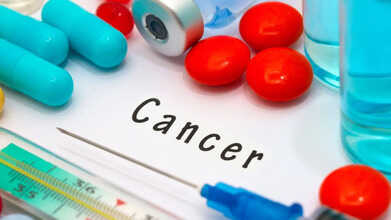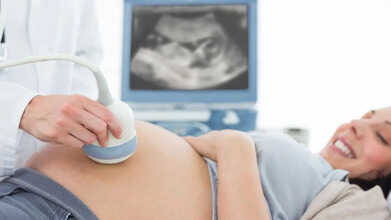- Health Conditions A-Z
- Health & Wellness
- Nutrition
- Fitness
- Health News
- Ayurveda
- Videos
- Medicine A-Z
- Parenting
How Vitamin D Deficiency In Winters Could Lead To Uterine Fibroids

Vitamins and minerals are essential for the body to function properly and to stay healthy. They help our body to convert food into energy, support growth and development and even boost the immune system. Often, when we do not consume enough vitamins, it can result in slowed down functions of our body.
While some vitamins and minerals could be gained from fruits, vegetables and certain food, vitamin D has a natural source, which does not require us to get fruits or vegetables from the market. It is the sunlight.
Sunlight Is a Source of Vitamin D
Sunlight is a great source of vitamin D. This is why Vitamin D is also known as the Sunshine Vitamin. During exposure to sunlight 7-dehydrocholesterol in the skin absorbs UV B radiation and is converted to previtamin D3, which in turn isomerises into vitamin D3.
However, as the winters are approaching, it can aggravate your Vitamin D deficiency. Your doctor will advise a 25-hydroxyvitamin D test to check the levels. As during the winter months, we mostly stay confined indoors, which can lead to shorter exposure to sunlight.
Studies have also investigated the link between vitamin D deficiency and uterine fibroids.
The Link Between Uterine Fibroids And Vitamin D
While studies neither confirm nor rule out the development of uterine fibroids when it comes to vitamin D deficiencies, here is how it could affect the condition.
Several studies have found a correlation between low levels of vitamin D and an increased risk of developing uterine fibroids. Published in the journal Epidemiology, a study noted that women with enough levels of vitamin D had 32% lower risk of developing fibroids compared to those with deficiency.
What Are Uterine Fibroids?
They are common, non-cancerous growths in the uterus that are made of muscles and connective tissues. Women who are between the ages of 35 to 55 usually report this, with symptoms such as heavy menstrual bleeding, back pain, frequent urination and pain during sex.
In another study published in Frontiers, the researchers found that a one-SD decrease in serum vitamin D levels was linked with a higher risk of uterine fibroids. However, it is important to note that these studies do not provide any conclusive results. However, experts do agree that vitamin D has anti-inflammatory and anti-fibrotic properties, which can contribute to its protective role against fibroids. Therefore, when the body lacks it, it may reduce the ability to protect against any inflammation.
Signs of Vitamin D Deficiency
- Extreme pain in lower back and joints
- Feeling fatigued
- Sudden mood changes
- Hair thinning or hair loss
- Slow wound healing
- Irregular period
- Muscle weakness
- Fall ill frequently
Four Medical Checks That Can Spot Cancer Before Symptoms Appear

Credits: Canva
Receiving a cancer diagnosis is scary, but what often causes greater harm is the delay in finding the disease and starting treatment. Many patients visit doctors only when symptoms become too obvious to ignore, by which time the illness has already advanced and is far harder to control. In most cases, cancer is caught late not because it hides well, but because people skip routine screenings.
In an Instagram video shared on November 6, Dr Jayesh Sharma, consultant surgical oncologist at ITSA Hospitals, spoke about four key tests that can help detect cancer early and reduce the number of late-stage cases.
4 Tests That Help Catch Cancer Early
Dr Sharma explained that there are four screenings everyone should consider. He noted that these tests can help identify cancer at the very first stage, when abnormal cells have formed but have not yet begun to spread. Detecting it at this point allows doctors to remove the cells completely, giving patients an excellent chance of recovery.
Mammography
Dr Sharma advised getting a mammogram once around the age of 40. He mentioned that while yearly tests are often suggested, most people do well with a screening every two years.
Cervical Cancer Screening
Cervical cancer remains one of the most common cancers in women. According to Dr Sharma, the Pap smear is a reliable way to catch early changes in cervical cells, even before symptoms appear.
Stool Test
He also recommended a stool test as a simple way to look for signs of stomach cancer. The earliest sign of trouble in the stomach is often hidden bleeding, which can be picked up through this test.
Chest CT Scan
For people who have been heavy smokers over many years, Dr Sharma suggested a chest CT scan. This group faces a higher chance of lung cancer, and a scan can help identify changes in the lungs at an early stage.
Symptoms Of Cancer
Warning signs of cancer can appear in many ways, and the symptoms usually depend on which part of the body is involved.
Some broad symptoms that may point to cancer, though they can occur in many other conditions as well, as per Mayo Clinic include:
- Fatigue that does not improve
- A lump or thickened area you can feel beneath the skin
- Unexpected weight loss or gain
- Changes in the skin, such as darkening, redness, yellowing, slow-healing sores, or new changes in moles
- Altered bowel or bladder habits
- A cough that lingers or ongoing breathing trouble
- Difficulty swallowing food
- A rough or hoarse voice
- Regular indigestion or discomfort after meals
- Ongoing, unexplained joint or muscle pain
- Recurring fevers or night sweats without a clear cause
- Bleeding or bruising without explanation
When To Seek Medical Advice
You should contact your doctor if any symptom continues for a long time or gives you reason to worry.
If you feel fine but are anxious about your cancer risk, speak with your doctor about it. They can guide you on the screening tests or checks that may be suitable for you
Can Egg Freezing Reduce Your Egg Quantity? Doctor Explains

Credits: Canva
Recent data from the Human Fertilisation and Embryology Authority show a sharp rise in the number of women opting for egg-freezing. Yet the subject remains clouded by many misunderstandings. The decision itself is not simple. It involves emotional questions, significant costs and the physical demands of treatment. One common misunderstanding is the belief that egg freezing can harm egg quality, when the procedure does not lower the inherent quality of the eggs you already have.
We got in touch with Dr Shaweez Faizi, Fertility Specialist, Nova IVF Fertility, Mangalore, who told us more about the same.
What Is Egg Freezing?
Egg freezing, also called oocyte cryopreservation, is a fertility option in which a woman’s eggs are collected, frozen, and kept for future use. The steps include taking hormones to help the ovaries produce multiple mature eggs, retrieving those eggs through a short clinical procedure, and freezing them through a rapid cooling method known as vitrification.
As per Healthline, the frozen eggs are then stored in liquid nitrogen. When pregnancy is planned later, the eggs are thawed, fertilized in a laboratory, and the embryo is transferred to the uterus.
How Egg-Freezing Works?
The journey begins with roughly 8 to 12 days of hormonal tablets and injections that help several follicles grow at once. Dr Shaweez Faizi told us that doctors then use an ultrasound-guided needle to retrieve the mature eggs under light anaesthesia. The eggs are preserved through vitrification. The medication does not pull eggs from future years. It acts only on that month’s cohort, which is why medical bodies consider the procedure safe and ethically sound.
Can Egg Freezing Lower Your Egg Quantity?
Dr Shaweez Faizi told us that egg-freezing does not drain your ovarian reserve for life. The process collects only the group of eggs that your body was already preparing to release in that month. Some women notice a short-term dip in AMH after the procedure, but this usually settles with time. The stored supply inside the ovaries remains unchanged.
For those unversed, AMH, or Anti-Müllerian Hormone, is commonly used to assess ovarian reserve, meaning the approximate number of eggs still present in a woman’s ovaries.
Anti-Müllerian Hormone and Reserve
AMH is often treated as a marker of ovarian reserve, though it naturally varies. Studies show that a small number of women experience a temporary fall in AMH after stimulation, followed by a return to baseline. Specialists usually advise repeating the AMH test a few months after retrieval to get an accurate picture.
Egg Freezing Success Rates
Age at the time of freezing and the number of eggs stored have the strongest influence on outcomes. Global data suggest that women under 38 who freeze about 20 eggs tend to have higher chances of a future live birth. Older women usually retrieve fewer eggs per cycle, and success rates decline. Indian clinics report a wide range of live-birth outcomes, depending on age and the number of usable eggs.
People with low AMH or diminished reserve will have fewer eggs from the start. The issue lies in the baseline biology, not in the freezing itself. Those who have had ovarian surgery, such as endometrioma removal, may have reduced reserve due to the operation and should plan their timing carefully.
Women facing chemotherapy or serious medical treatment should consult both oncologists and fertility specialists. The Indian Fertility Society recently issued guidance on handling low ovarian response and preservation choices.
Practical Steps For Those Considering Egg Freezing
Dr Shaweez Faizi shared a few practical steps for women considering egg freezing:
• Start with basic tests such as AMH, AFC and a hormonal panel.
• Ask detailed questions about expected egg yield for your age, the number of cycles you may need, and the clinic’s real success figures. Advertising often paints a brighter picture than the data.
• Plan financially for medication, scans, retrieval, freezing and long-term storage.
• Keep age in mind, as younger eggs are more likely to develop into healthy embryos.
• Choose established centres that follow national and international practice standards.
Egg-freezing is a recognised and safe method to preserve fertility options, but it is not a guaranteed path to pregnancy.
Costs, success rates and the number of cycles needed vary widely. As the service becomes more accessible in India’s metropolitan centres, careful counselling and realistic planning remain essential before you decide.
Azithromycin Warning: Popular Medicine Linked To A Surge in Antibiotic Resistance, Warns Ortho Surgeon

Credits: Canva
India’s growing dependence on quick, over-the-counter remedies has drawn fresh concern from a senior orthopaedic and sports surgeon in New Delhi. In a recent Instagram video, Dr Obaidur Rahman of Dr Ram Manohar Lohia Hospital warned that the country’s casual use of a common antibiotic is undermining its effectiveness and pushing India closer to a major public health challenge. His message, shared through a post and video, called attention to an urgent issue that often goes unnoticed in everyday medical choices.
What Is Azithromycin?
Azithromycin, sold under brand names such as Zithromax, Azee and Zmax, is a macrolide antibiotic prescribed for various bacterial infections. It works by slowing the growth of harmful bacteria. It does not help with viral illnesses like the common cold or flu, according to MedlinePlus.
Azithromycin Is Being Used “More Than Toffee or Roti”
Dr Rahman explained that one particular antibiotic has become so familiar in Indian homes that many people take it without a second thought. He noted that families frequently reach for this medicine to treat colds, coughs and mild fevers, despite the fact that most of these illnesses are viral. Because antibiotics do not work on viruses, this habit has increased unnecessary exposure and created ideal conditions for resistance to form.
In his post, he described the extent of the overuse by saying that the tablet is consumed even more commonly than basic household foods. This pattern, he said, has quietly pushed India into a vulnerable zone.
Azithromycin Antibiotic Resistance: Azithromycin Losing Power Against Key Bacteria
The antibiotic at the center of his warning is Azithromycin, a drug often prescribed for sore throats and upper respiratory tract infections. Dr Rahman noted that it was once effective against Mycoplasma Pneumonia, a bacterium responsible for pneumonia in adults and children.
He pointed out that this is no longer the case. According to him, India now shows an alarming 80 to 90 percent resistance to Azithromycin when treating infections caused by this bacterium. A medicine that once addressed a wide range of respiratory problems is no longer reliable for many patients.
Azithromycin: Antibiotic Resistance Already Reaching Clinics
Dr Rahman said that antibiotic resistance is not an abstract idea but something he encounters in his orthopaedic practice. He has seen cases where routine antibiotics fail entirely, leaving patients with few options. When commonly used drugs stop working, he added, treatment becomes more complicated, more expensive, and sometimes impossible.
His concern is that if such misuse continues unchecked, India could face a situation where even simple infections become difficult to manage.
The surgeon urged people to avoid taking antibiotics without proper medical advice. Most seasonal respiratory infections resolve on their own, and unnecessary drugs only add to the resistance problem. He encouraged viewers to share the information, especially with those who often purchase antibiotics over the counter.
Azithromycin Warning: Why This Warning Matters Now
Dr Rahman, who works at PGIMER and RML Hospital and specialises in bone, joint and sports injury care, said his experience treating a large volume of patients has made the issue impossible to ignore. He believes that without immediate changes in how antibiotics are used, India risks losing access to medicines that save lives in emergencies.
His message acts as a reminder that antibiotic resistance does not appear suddenly. It builds slowly through small, routine choices. And, as he warns, the cost of ignoring these early signs may be far greater than most people realise.
© 2024 Bennett, Coleman & Company Limited

